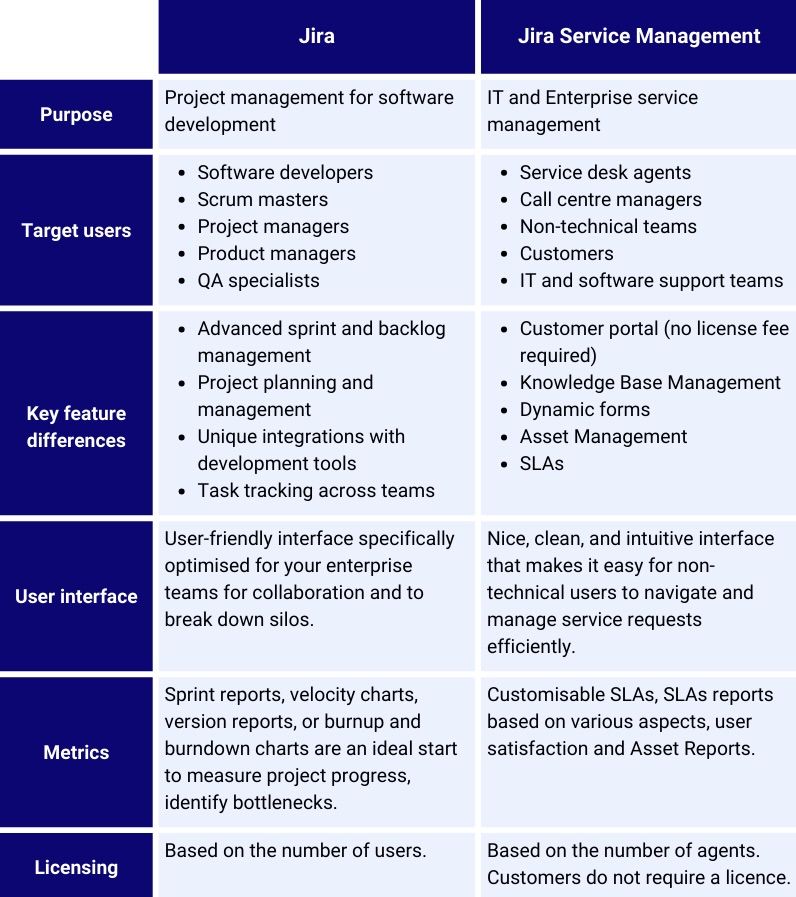Jira Service Management vs Jira Software: What’s the difference?
Share on socials
Jira Service Management vs Jira Software: What’s the difference?

Deniz Timartas
Published on 15 May 2024
4 min read


Deniz Timartas
Published on 15 May 2024
4 min read
When it comes to maximising the effectiveness of teamwork, businesses need to select the right collaboration software. Both Jira and Jira Service Management (JSM) are powerful tools that offer numerous benefits to organisations looking to streamline their service delivery and communications. However, sometimes, there is a slight overlap between the functions of the tools that isn’t always obvious. This makes it difficult for non-experts to decide which is best for their unique needs.
In this blog post, we’ll highlight the main capabilities, use cases, and differences between Jira and Jira Service Management to help you understand which fits your team best.
History explained: Jira and Jira Service Management
What is Jira?
Jira now enables teams such as software development, project and marketing to track bugs and issues together. The software includes various features for conducting scrum and agile project management. With its multiple Kanban and scrum boards, teams can efficiently visualise workflows and track complex projects in real-time.
Due to the integration of Jira software and Jira Work Management to create Jira, has extended the functionality of the platform, allowing its users to plan and organise tasks using kanban boards, align goals across teams and birds-eye-view of your teams' performance across projects.
Jira Software is licensed based on total users; every user who interacts directly with Jira Software in any way will need a licence.
What is Jira Service Management?
Jira Service Management (formerly known as Jira Service Desk) is service desk software built for teams who receive incoming issues and requests from other teams/customers.
The tool offers an intuitive self-service customer portal that allows users to create requests and check their status. With several features—such as workflow automation, customisable SLAs, rules-driven alerts and notifications, and dynamic work queues—Jira Service Management can easily support the varied needs of any service-driven organisation.
Key differences between Jira and Jira Service Management

Here is a table that summarises the key differences between the two products
Can you use both Jira and JSM?
Absolutely, but whether it's necessary to have both really depends on your specific business needs.
In some cases, using both tools can optimise different aspects of your business. For instance, you could handle your projects in Jira. Once they are released to the customer, you can offer them a portal from Jira Service Management to submit issues or new requests.
Also, since both products are built on a common platform, you can seamlessly integrate them for effective collaboration between your development, operations, support, and IT teams. Service teams can address customer problems and requests by linking Jira Service Management tickets to issues in Jira, if or when an issue needs developer attention. Development teams can also jump in to view and comment on issues in your service project.
Summing up
Reading this blog, you should understand how Jira differs from Jira Service Management. While both tools provide robust project management solutions, the correct answer for you will always depend on the unique needs of your team and the goals they want to accomplish.
If you need support choosing the best software solution, contact our expert team.
Written by

Strategic Advisor
Deniz Timartas is a strategic advisor that uses Atlassian tools and ITSM best practices to help customers achieve efficiency and success. Deniz is also an ITIL Managing Professional and trainer.